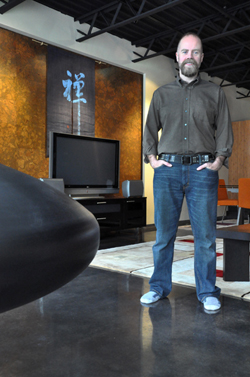 We can build an entire industry in this region by thinking differently about power, says one energy entrepreneur. Just look at what’s happening already. From small to large companies, and including universities, Pittsburgh is already the envy of the industry thanks to our manufacturing base and plentiful green resources.
We can build an entire industry in this region by thinking differently about power, says one energy entrepreneur. Just look at what’s happening already. From small to large companies, and including universities, Pittsburgh is already the envy of the industry thanks to our manufacturing base and plentiful green resources.
Green energy has never been more affordable or accessible to Pittsburghers than it is today.
Take the case of Dr. Mike Ramsey, Associate Professor in the Department of Geology and Planetary Science at the University of Pittsburgh. In layman’s terms, he’s a volcanologist, someone who knows a thing or two about massive sources of energy. So naturally, he incorporated solar energy into the adaptive reuse of a 60s-era building on the North Side.
The entire structure was gutted, with 90% of the interiors recycled. Energy efficiency was incorporated throughout, from insulation to furnace and double-pane storefront windows. A 20 x 20′ courtyard was cut into the center of the mid-block building and this glass-walled “light well” provides cross-ventilation alongside a green space that keep things cool. The green roof is snug against an expansive photo-voltaic (solar) array.
“I always wanted to do solar,” says Ramsey. “It mirrors my views on renewable energy. Since this is a mixed-use building, half residential and half commercial, it looked like it might not work out, ” he says. But then he explains that Astrum Solar popped up and they did all the paperwork for applications with the city, the electric company and the certificates for solar RECs (Renewable Energy Credits). The rebates were substantial, returning 50% of the cost of the install. “
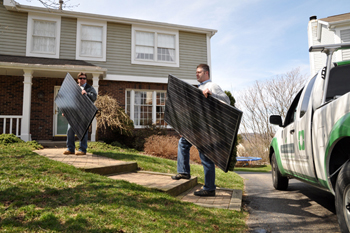 That plus the RECs put my payback period at 2 1/2 years where two years ago, it was a ten-year payback!” he says.
That plus the RECs put my payback period at 2 1/2 years where two years ago, it was a ten-year payback!” he says.
Ramsey’s enthusiasm for solar energy is echoed by many of Astrum Solar’s customers. As one of the largest residential solar installers in the state (close to 400 installs in 2010), they are facile with the many-layered process of applying for state and federal grants as well as RECs. Those are the market-based instruments that facilitate the purchase of renewable energy by large utilities obligated to do so as part of the Alternative Energy Portfolio Standards (AEPS). And that is a state law that dictates the percentage of green energy (solar, wind, etc.) which must be purchased by power companies.
Easy as R-E-C
Another benefit for consumers is net metering, where excess energy collected via a solar array effectively winds the electric meter back, reducing a customer’s bill. Conversely, if a customer needs more traditional power from his utility, the meter ticks forward. Consumers have full control over their personal power choices in Pennsylvania and can purchase RECs even if they don’t own and operate a solar or wind system. Putting your green into green is as easy as R-E-C.
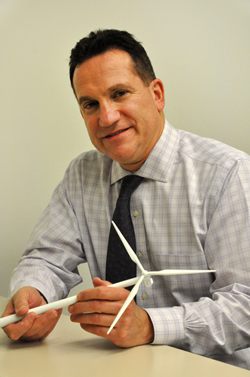 The nuclear catastrophe resulting from the massive earthquake in Japan, coupled with Marcellus Shale woes here at home, have put the spotlight on clean energy like never before and the region is uniquely positioned to benefit. Contrary to popular belief, southwestern Pennsylvania’s gray skies are a better source of “insolation,” the amount of radiation generated by the sun, than Germany, whose use of solar far eclipses our own. We also benefit from having the Allegheny Ridge and its considerable wind power so close.
The nuclear catastrophe resulting from the massive earthquake in Japan, coupled with Marcellus Shale woes here at home, have put the spotlight on clean energy like never before and the region is uniquely positioned to benefit. Contrary to popular belief, southwestern Pennsylvania’s gray skies are a better source of “insolation,” the amount of radiation generated by the sun, than Germany, whose use of solar far eclipses our own. We also benefit from having the Allegheny Ridge and its considerable wind power so close.
Nearly twenty solar installers are currently working in the region while a handful of companies are creating innovative solar technologies that could lead to large-scale manufacturing. Plextronics, located at the University of Pittsburgh Applied Research Center (U-PARC) in Harmar Township, takes a different approach than traditional solar manufacturers by incorporating solar directly into objects that need power. Example: the empty real estate around that cute apple on your laptop could be lined with a thin solar skin that powers the entire unit. The possibilities for portable devices (smart phone, Kindle, etc.) are considerable, which is why CEO Andy Hannah is excited.
“We see a whole new wave of products, including signage in grocery stores that will have motion, change pricing and be powered by the energy from fluorescent light. Power is important. In four decades, we will triple the amount of power needed globally. Where will we get those electrons? We need to think differently about how we access power and, if we do, we can build an entire industry around this in the Pittsburgh region.”
 Harnessing the region’s wind energy is EverPower, a New York-based company with offices in Lawrenceville. Much like solar, wind power is scalable and commercially achievable and the resource along the Allegheny Ridge, which spans West Virginia into Canada, is considered the best in the eastern U.S.
Harnessing the region’s wind energy is EverPower, a New York-based company with offices in Lawrenceville. Much like solar, wind power is scalable and commercially achievable and the resource along the Allegheny Ridge, which spans West Virginia into Canada, is considered the best in the eastern U.S.
EverPower currently has two wind farms in Cambria County and is building a third in Somerset County. Presently, roughly 750 megawatts (MW) of wind power are being generated in Pennsylvania although conservative estimates put the state’s potential wind capacity at over 5,000 MW.
“We take a very integrated approach to wind,” says Jim Spencer, EverPower CEO, about the company’s efforts to work with large regional employers such as Bayer and PPG, the latter a global leader in fiberglass wind blades. The company has also partnered with the Pittsburgh Technology Council (PTC) to “create a very unique Pennsylvania wind product. When you purchase wind, you could be buying Texas wind or Kansas wind but we will be selling local wind made by Pennsylvania-built wind farms using local labor. The PTC will market the product to its member companies and it’s a win-win for both.”
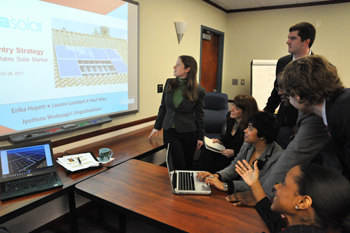 Putting a unique spin on green energy is Robert Sroufe, who leads the Sustainability MBA program at Duquesne University. Twice ranked in the top twenty worldwide for its integration of business and curriculum by the Aspen Institute, the 12-month program offers plentiful opportunity to study global economies firsthand and how they confront energy challenges.
Putting a unique spin on green energy is Robert Sroufe, who leads the Sustainability MBA program at Duquesne University. Twice ranked in the top twenty worldwide for its integration of business and curriculum by the Aspen Institute, the 12-month program offers plentiful opportunity to study global economies firsthand and how they confront energy challenges.
To wit: China poses the duality of a dense, highly-industrialized society that is also home to remote, agrarian economies whereas India’s large democratic society is keenly aware of the environmental impact of its own industrial revolution. The goal is for students to embrace a triple-bottom-line approach and differentiate themselves from others who don’t. Equally important, they are auditioning for jobs here at home.
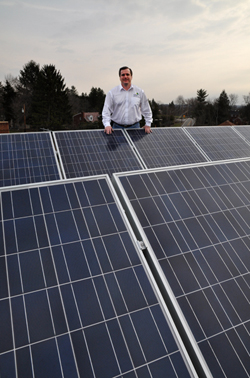 “We just completed our 45th local consulting project so we are having a tangible impact on the region,” notes Sroufe. “We want to contribute to the growth and evolution of sustainability in Pittsburgh. We’ve worked with Westinghouse, Bayer, Phipps, UPMC and the City of Pittsburgh and work with smaller companies through our Idea Cafe, half-day engagements that tackle a current project or need in a sustainable and responsible way.”
“We just completed our 45th local consulting project so we are having a tangible impact on the region,” notes Sroufe. “We want to contribute to the growth and evolution of sustainability in Pittsburgh. We’ve worked with Westinghouse, Bayer, Phipps, UPMC and the City of Pittsburgh and work with smaller companies through our Idea Cafe, half-day engagements that tackle a current project or need in a sustainable and responsible way.”
Bringing it all home is Rich Foltz, Founder and President of Vox Energy Solutions, a solar installer based in Allison Park. He sees the need for everyone to get on the green energy bandwagon now.
“The fossil fuel industries receive $72 billion a year in subsidies whereas renewable energy receives only $8 billion. A greater investment in [research of] wind turbines and solar cells will cut the cost of these systems almost in half. We’ll see the biggest impact of this industry on our kids and grandkids because it is guaranteed that fossil fuels will run out.”
Why wait? Green energy is here today and the savings will only increase over time.
New Girl In Town Elaine Labalme maintains a sunny disposition on the grayest of Pittsburgh days. Send feedback here.
Photos:
Mike Ramsey at home, along with Fireorb.
Bob Cleland (left) and Mark Buckley of Astrum Solar, at the home of one of Astrum’s domestic clients.
Jim Spencer of Everpower
Robert Sroufe of Duquesne University’s Sustainability MBA Program at the site of one of Vox Energy’s solar array installations.
Duquesne University MBA students discuss a solar energy presentation.
Phil Long of Vox Energy.
Photos copyright Brian Cohen
